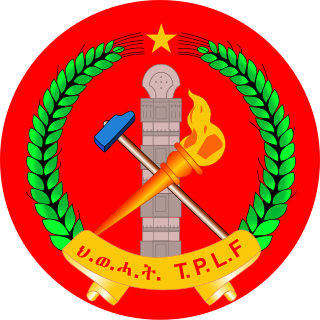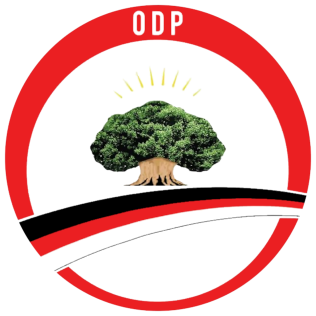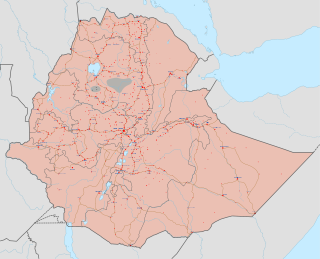
The politics of Ethiopia are the activities associated with the governance of Ethiopia. The government is structured as a federal parliamentary republic with both a President and Prime Minister. The government is multicameralism with a house of representative and a council. The term politics of Ethiopia mainly relates to the political activities in Ethiopia after the late 20th century when the democratization took place in the nation. The current political structure of Ethiopia was formed after the Tigrayan People's Liberation Front (TPLF) overthrew dictator President Mengistu Haile Mariam in 1991. General election was held in June 1994 and Ethiopia has maintained a multiparty political environment till today.

Mengistu Haile Mariam is an Ethiopian politician and former army officer who was the head of state of Ethiopia from 1977 to 1991 and General Secretary of the Workers' Party of Ethiopia from 1984 to 1991. He was the chairman of the Derg, the socialist military junta that governed Ethiopia, from 1977 to 1987, and the president of the People's Democratic Republic of Ethiopia (PDRE) from 1987 to 1991.

Meles Zenawi Asres was an Ethiopian soldier and politician who served as President of Ethiopia from 1991 to 1995 and then Prime Minister of Ethiopia from 1995 until his death in 2012.

The Ethiopian People's Revolutionary Democratic Front was an ethnic federalist political coalition in Ethiopia that existed from 1988 to 2019. It consisted of four political parties, namely Tigray People's Liberation Front (TPLF), Amhara Democratic Party (ADP), Oromo Democratic Party (ODP) and Southern Ethiopian People's Democratic Movement (SEPDM). After leading the overthrow of the People's Democratic Republic of Ethiopia, it dominated Ethiopian politics from 1991 to 2019. In November 2019, the EPRDF was dissolved, and Prime Minister and EPDRF chairman Abiy Ahmed merged three of the constituent parties into his new Prosperity Party, which was officially founded on 1 December 2019.

Oromia is a regional state in Ethiopia and the homeland of the Oromo people. The capital of Oromia is Addis Ababa.

The Tigray People's Liberation Front, also called the Tigrayan People's Liberation Front, is a left-wing ethnic nationalist paramilitary group, a banned political party, and the former ruling party of Ethiopia. It is designated as a terrorist organization by the Ethiopian government. It is widely known as Woyane or Wayane in older texts and Amharic publications.

The Ethiopian People's Revolutionary Party (EPRP), informally known as Ihapa, is the first modern political party in Ethiopia, established in April 1972. Its first political program called for the overthrow of the Ethiopian monarchy, the removal of the feudal system, and the creation of a socialist democratic republic. The party was forced underground because the monarchy, headed by Emperor Haile Selassie, did not allow political parties or legal dissent.

The Oromo Democratic Party was a political party in Ethiopia, and part of the alliance with the Amhara National Democratic Movement, the South Ethiopian Peoples' Democratic Front and the Tigrayan Peoples' Liberation Front that forms the Ethiopian People's Revolutionary Democratic Front (EPRDF). In the August 2005 Regional assembly elections, the party won 387 out of 537 seats in the Oromia, and 14 out of 36 seats in the Harari Region.

The Oromo Liberation Front is an Oromo nationalist political party formed in 1973 to promote self-determination for the Oromo people inhabiting today's Oromia Region and Oromia Zone in the Amhara Region of Ethiopia. The OLF has offices in Addis Ababa, Washington, D.C. and Berlin from where it operates Amharic and Oromo radio stations.

General elections were held in Ethiopia on 7 and 18 May 1995 for seats in its Council of People's Representatives; elections in the Afar, Somali, and Harari Regions were delayed until 28 June to assign experienced personnel who could solve possible conflicts and irregularities. This was the first regular multi-party election in Ethiopian history, and the first election since the adoption of a permanent constitution the previous December. Several opposition parties boycotted the election, including the All-Amhara People's Organization, Council of Alternative Forces for Peace and Democracy in Ethiopia, and Ethiopian Democratic Unity Party.
Tesfaye Dinka Yadessa was an Ethiopian politician who was Minister of Finance (1983–1986), Minister of Foreign Affairs (1989–1991), and Prime Minister of Ethiopia. He was the head of the delegation of the Ethiopian Government during the London Conference of 1991 which aimed to end the Ethiopian Civil War.

Elections for a Constituent Assembly were held in Ethiopia on 5 June 1994 in order to form a body to draw up a new constitution. They were the first elections after the overthrow of the Mengistu regime at the end of the Ethiopian Civil War in 1991, and the first ever multi-party elections in the country; previous elections had either been non-partisan or one-party. The results saw the Ethiopian People's Revolutionary Democratic Front and its allies win 463 of the 544 seats. Voter turnout was 87.5%.

The Transitional Government of Ethiopia (TGE) was an era established immediately after the Ethiopian People's Revolutionary Democratic Front (EPRDF) seized power from the Marxist-Leninist People's Democratic Republic of Ethiopia (PDRE) in 1991. During the transitional period, Meles Zenawi served as the president of the TGE while Tamrat Layne was prime minister. Among other major shifts in the country's political institutions, it was under the authority of the TGE that the realignment of provincial boundaries on the basis of ethnolinguistic identity occurred. The TGE was in power until 1995, when it transitioned into the reconstituted Federal Democratic Republic of Ethiopia that remains today.
Lencho Letta is an Ethiopian politician and Oromo activist who was founding member of Oromo Liberation Front (OLF). He was the Deputy Secretary General of the Oromo Liberation Front (OLF) from 1974 to 1995. In Late 1990s, Lencho left OLF leadership due to ideological differences. He is currently the leader of Oromo Democratic front, which was formed in 2013.

The Oromo conflict is a protracted conflict between the Oromo Liberation Front (OLF) and the Ethiopian government. The Oromo Liberation Front formed to fight the Ethiopian Empire to liberate the Oromo people and establish an independent state of Oromia. The conflict began in 1973, when Oromo nationalists established the OLF and its armed wing, the Oromo Liberation Army (OLA). These groups formed in response to prejudice against the Oromo people during the Haile Selassie and Derg era, when their language banned from public administration, courts, church and schools, and the stereotype of Oromo people as a hindrance to expanding Ethiopian national identity.

Many of the roots of the ongoing civil conflict within Ethiopia date back to the mid-twentieth century and earlier. Following the 2018 dissolution of the ethnic federalist, dominant party political coalition, the Ethiopian People's Revolutionary Democratic Front, there was an increase in tensions within the country, with newly resurgent regional and ethnically based factions carrying out armed attacks on military and civilians in multiple conflicts throughout Ethiopia.

The Amhara genocide is an ongoing and systematic massacre of ethnic Amhara and Agew people in Ethiopia since 1990 Large-scale killings and grave human rights violations followed the implementation of the ethnic-federalist system in the country. In most of the cases, the mass murders were silent with perpetrators from various ethno-militant groups— from TPLF/TDF, OLF–OLA, and Gumuz armed groups.

The fall of the Derg, also known as Downfall of the Derg, was a military campaign that resulted the defeat of the ruling military junta Derg by the rebel coalition Ethiopian People's Revolutionary Democratic Front (EPRDF) on 28 May 1991 in Addis Ababa, ending the Ethiopian Civil War. The Derg took power after deposing Emperor Haile Selassie and the Solomonic dynasty, an imperial dynasty of Ethiopia that began in 1270. The Derg suffered insurgency with different factions, and separatist rebels groups since early their rule, beginning with the Ethiopian Civil War. The 1983–1985 famine, the Red Terror, and resettlement and villagization infamed the Derg with majority of Ethiopians tended to support insurgent groups like the Tigray People's Liberation Front (TPLF) and Eritrean People's Liberation Front (EPLF).

Federalism in Ethiopia can be best explained by considering the ethnic and geographic diversity of modern-day Ethiopia, interpreted through the history of the nation’s reunification. Ethiopia contains over 80 ethnic groups of varying sizes, languages, religions and customs. According to the 2007 census, the top seven groups constitute 83% of the population. Ethiopia is mainly a rural country, with an urbanisation rate of only 23.2% (2023) and exhibits a wide variety of topography that impacts agricultural and economic activity.
This list details about chronological aspect of the Derg, the military junta that ruled Ethiopia from 1974 to 1987 by decade.













